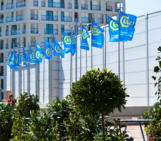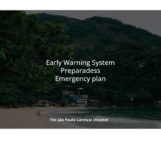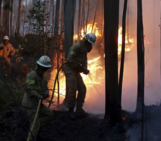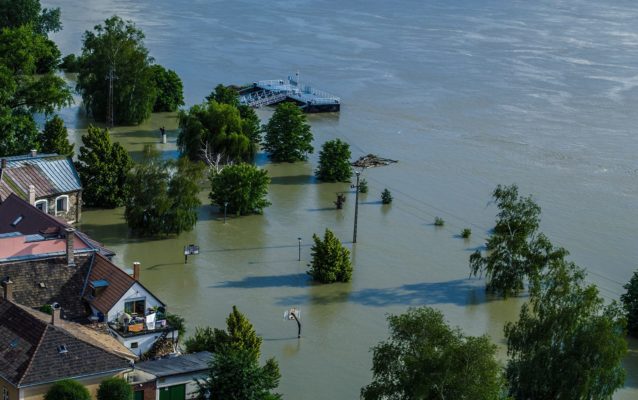
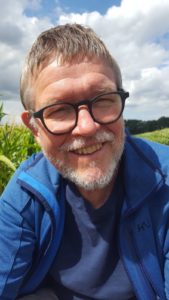
Henny van Lanen.
In this post, I have the pleasure to interview Dr.ir. Henny A.J. van Lanen. He is Associate Professor in the Hydrology & Quantitative Water Management Group of Wageningen University and he has been involved in several EU projects. Further, he is involved in many international groups or networks:
- Coordinator of the European FRIEND programme (EURO-FRIEND Water, Flow Regimes from International Experimental and Network Data; cross-cutting theme UNESCO-IHP);
- Past Global Coordinator of the FRIEND Inter-Group Coordination Committee (FIGCC) (cross-cutting theme UNESCO-IHP);
- Coordinator of the European Drought Centre (EDC);
- Member of the Open Panel of CHy Experts (OPACHE) of Commission of Hydrology (CHy) from the World Meteorological Organization (WMO);
- member of the Discussion Group on Droughts of the UN-International Strategy on Disaster Reduction (UN-ISDR);
- member/chair of the Project Review Group of Global Water Partnership (WM-GWP) on Integrated Drought Management in Central and Eastern Europe (CEE-IDMP).
1. Media are talking more frequently of extreme weather and climate events: why are they so important for our society?
Extreme Weather and Climate events (W&C) cause natural hazards, and when vulnerable human and natural systems are exposed to these W&C hazards, they may lead to disasters. For instance, from 2011 to 2013, the USA faced 24 weather-related disasters that led to about 1100 fatalities, which resulted in more than $200 billion in losses. Similar experiences of weather-induced disasters and their associated losses are reported for Europe. Moreover, there seems to be a growing trend. Summer 2019 has barely begun, but temperature records are already being broken. Recent data show that the European-average temperature for June 2019 was higher than for any other June on record. Average temperatures were more than 2°C above normal and it has become the hottest June ever recorded. This led to associated dry hazards, e.g. wildfires, but also to abrupt endings, like the powerful early-July storm in northern Greece that killed six people. The apparently rising trends go hand in hand with increasing populations, assets and ecosystems’ risk.

Dry, natural hazards (drought, heatwaves, wildfires) cause severe impacts and likely will intensity in the future in multiple areas across the world (photos: Henny Van Lanen).
2. Is there attention from the European institutions toward extreme weather and climate events?
To face the challenge of the W&C extreme events, the European Commission (EC) found it crucial to encourage innovation actions to develop tools to support decision-makers in real-time coordination of emergency management operations. There is the general feeling that skills to anticipate them exist (depending on the hazard, from a few hours, e.g. flash floods, to months, or seasons in the case of droughts). So, response/emergency management of W&C induced hazards can start before the event occurs, which makes them different from other hazards and emergencies (e.g. earthquakes or industrial accidents). Unfortunately, Civil Protection, Water Managers and other First Responders are usually forced to respond once the emergency occurs or the disaster is in place (reactive approach). And the classical concept of response is more focused to deal with damages, causalities, and the coordination of the units deployed, focusing on a limited range of technologies to be used to support the deployment of this kind of reactive response and operation. A pro-active approach has to be implemented, and hence, innovation actions should capitalize on advances in observation systems and in forecasting models capable of anticipating W&C phenomena triggering associated natural hazards and their impact. The most prominent challenge is to close the enormous gap between what “can be done” and what is “really done”. As a response, EC funded the ANYWHERE (EnhANcing emergencY management and response to extreme WeatHER and climate Events) innovation action (http://anywhere-h2020.eu/) that started mid-2016 and will run until the end of 2019. It is a project within EU’s Horizon 2020 research and innovation programme.
3. Can you introduce the ANYWHERE project?
The ultimate purpose of the ANYWHERE project is to empower responder institutions and exposed people to enhance their anticipation and pro-active capacity of response to face extreme and high-impact W&C events through the use of cutting-edge innovative technology as the best way to enhance citizen’s protection and saving lives. The ANYWHERE consortium consists of 34 partners (13 RTD partners, i.e. coordinators from previous EU projects on natural hazards, 12 Operational Authorities, and 9 SMEs) coming from 11 different countries.
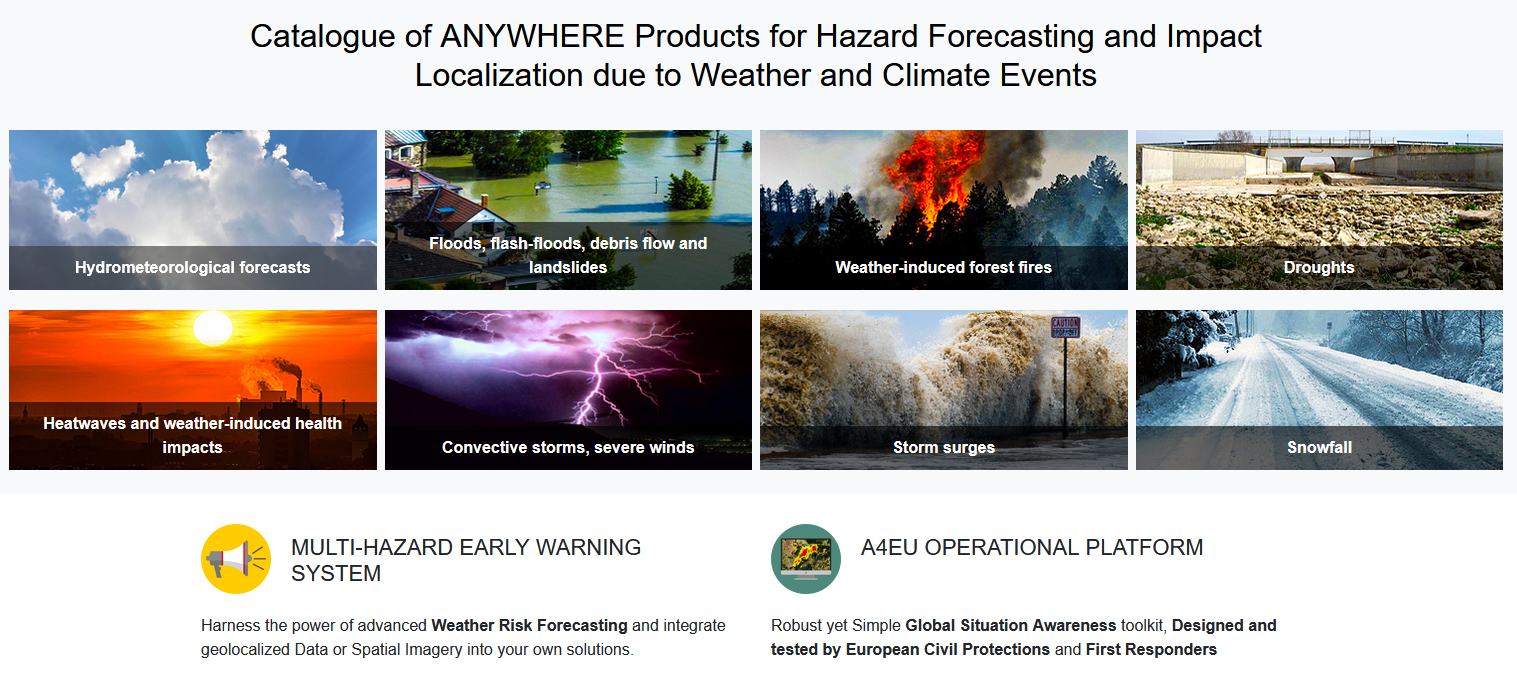
The ANYWHERE Catalogue (http://anywhere-h2020.eu/catalogue/) that describes nowcast and forecast tools/algorithms and the resulting products.
ANYWHERE covers nowcasting/forecasting of the following natural hazards:
- convective storms, severe winds
- precipitation type, incl. snow load
- riverine floods and flash floods
- landslides and debris flows
- storm surges
- heatwaves
- wildfires
- droughts
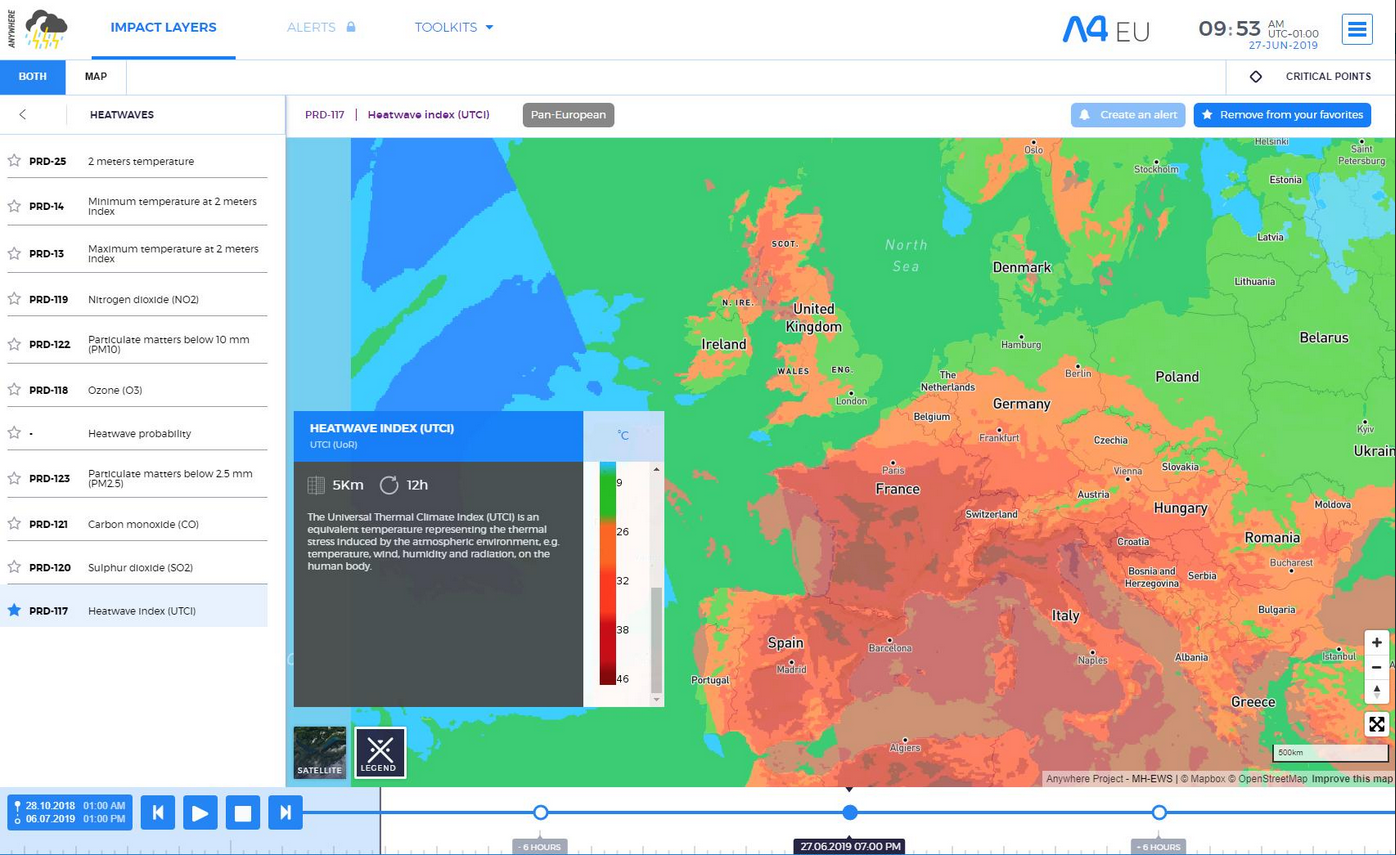
Universal Thermal Climate Index (UTCI, ANYWHERE product no. 117) on 27 June 2019 (forecasts available until 6 July 2019 (Source: Di Napoli, Univ. of Reading/ECMWF). The UTCI describes heat stress (the darker red the higher human discomfort).
The basis for ANYWHERE Multi-Hazard Early Warning System (MH-EWS) is probabilistic weather forecasts with different lead times from sub-daily to seasonal (7 months) for the pan-European domain, which are complemented by radar data. Additionally, probabilistic hydrological forecasts (e.g. soil water, river flow), wildfires and drought from existing EU Platforms (EFAS, EFFIS and EDO) are connected to the MH-EWS. Tens of algorithms/tools employ these data to compile pan-European maps and time series with nowcast/forecast of natural hazards. In total over 300 products are generated.
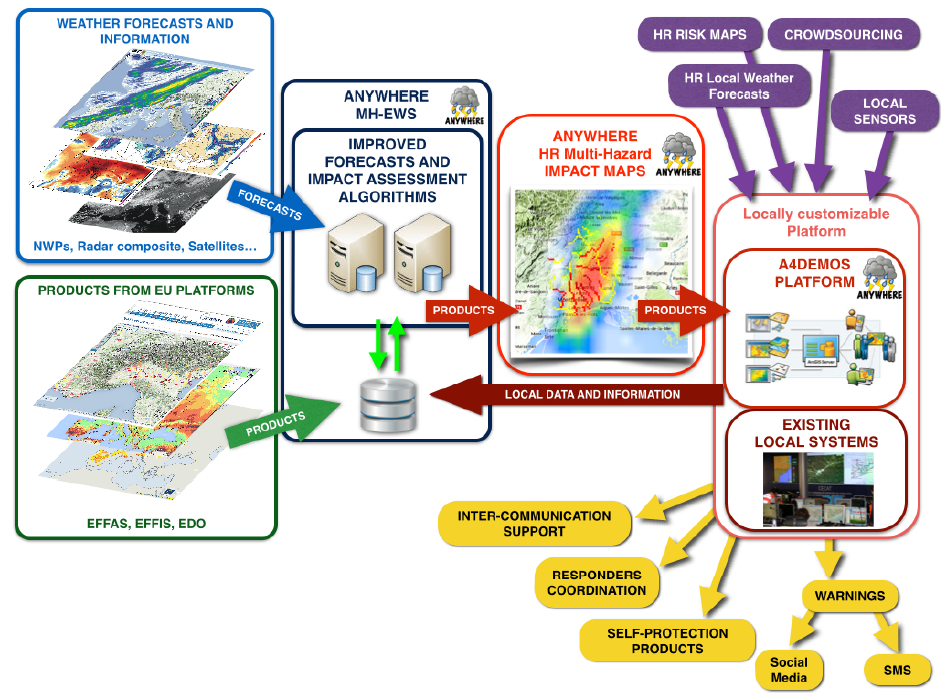
4. What is the ANYWHERE approach?
The multi-hazard assessment products generated by the MH-EWS at Pan-European scale will serve as input for the ANYWHERE platform for Decision support in Emergency Management Operation Services (A4DEMOS, i.e. A4EU platform). The decision support will provide early warning products. In most cases, the pan-European nowcast/forecast products are too broad, that is, a too low spatial resolution for local applications. A4EU offers functionalities to include high-resolution information to arrive at local customized platforms targeted to the requirements of the users.
The A4EU platform includes, among others, the following specific skills:
- capacity to include detailed local exposure, vulnerability and risk maps
- capacity to include high-resolution, locally more representative weather forecasts
- capacity to incorporate local sensors and local sources of information (including crowdsourcing)
- capacity to share information and interconnect various responders and operators (including hospitals, fire brigades, logistics agencies)
- capacity to adapt multi-hazard impact assessment products generated by the MH-EWS to a specific environment specified by users, incl. advanced geospatial web services capabilities
- enhanced social media communication skills based on the effectiveness of the emergency warnings.
- capacity to disseminate publicly available online now- and fore-casting hazard assessments for disasters.
5. Where are you testing your platform?
The verification of the ANYWHERE MH-EWS nowcast and forecast products and the demonstration of how to implement the A4EU platform on a given site, incorporating the specific requirements, information available and operation protocols, is being carried out in six selected Pilot Sites representing different climatic regions in Europe:
- Catalonia region (ES)
- Liguria region (IT)
- Swiss Alps (CH)
- South Savo region (FI)
- Rogaland region (NO)
- Corsica island (FR).
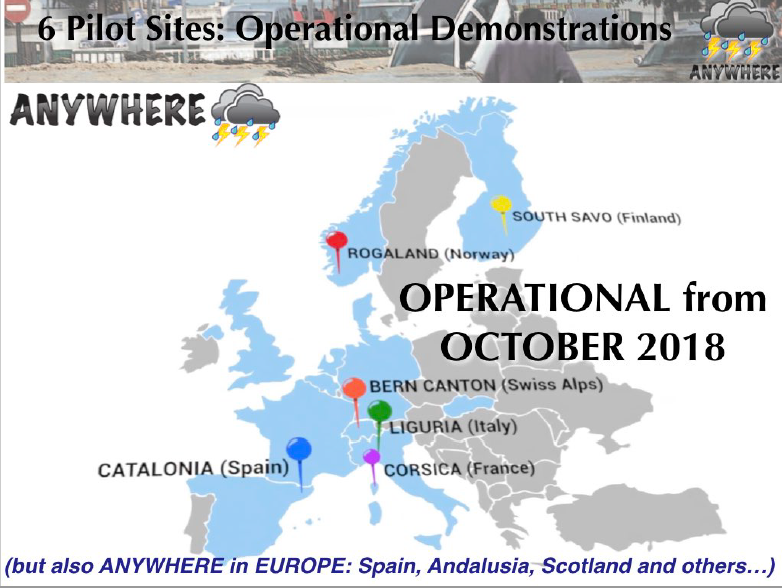
ANYWHERE Pilot Sites where the MH-EWS and decision-support platforms (locally customized A4EU) are being operationally run and evaluated.
During the 12-month piloting phase that started October 2018, the adapted A4EU prototypes (A4CAT, A4LIG, A4ALPS, A4FIN etc.) are being operationally run (24/7) on the emergency control centres (e.g. Civil Protection) or the institutions in charge of the Pilot Sites. The selected validation Pilot Sites are regions, including cities and rural areas, frequently affected by different hazards. The validation activities consist of the integration of the A4EU platform of products and services in the control centres of operational responders, providing a show-room for the platform and offering the opportunity to integrate and demonstrate third-parts add-on applications. The full evaluation of the platform of products and services in the Pilot Sites employs an independent measure of the benefits of the support that the ANYWHERE developments provide to the emergency operation managers relative to decisions that would have been taken during real events in absence of the ANYWHERE developments. The evaluations are led by the emergency control centres or the institutions in charge of the Pilot Sites and are based upon the feedback of organisations/institutions (~ stakeholders) that for their activities are dependent on the decisions of the emergency control centres.
To demonstrate and evaluate the ANYWHERE approach for increased self-preparedness and self-protection of the population, four case studies for testing the new technologies and tools are being carried out in selected project Pilot Sites. These include:
- a service for camping sites in flash flood areas (providing warnings for both the camping managers and the campers themselves)
- a service to anticipate the impact of the weather conditions in the schools located in flash flood areas to help the authorities to inform the parents affected to improve their response during weather events causing severe floods
- a service on forecasting disturbances in electricity networks oriented to reduce storm-driven impacts on electricity transmission grids
- a service for logistics platforms of food distribution companies (considered in many countries as priority services to keep running during weather-induced emergencies) in case of snow events in the southern European roads.
Furthermore, a large-scale more broad operational validation of the products and services is being conducted. This includes:
- entire Europe (Pan-European coverage)
- selected areas to explore the potential of adaptation the A4EU platform to the local specificities and protocols (e.g. Spain, Andalusia, Scotland).
In addition to the meetings with stakeholders in the Pilot Sites, which are involved in the evaluation of the local customized A4EU, the ANYWHERE consortium discusses each year the performance of the MH-EWS and the decision-support platforms with the so-called Stakeholder’s Board, which consists of 52 members from all over Europe. The Board is composed of members involved in the management of emergencies, covering the full chain of the response from first responders to national law enforcement agencies, climate and weather services, civil protection agencies, public and private operators of critical infrastructures and networks, and management institutions dealing with pro-active measures (like water agencies, non-governmental organizations or citizen’s associations). It was a challenge to recruit these members and in particular to keep the first-hour members interested during the first 2-year development stage (June 2016 – October 2018) of the ANYWHERE innovation action. Clearly, members are eager to quickly see results to decide if the MH-EWS and decision support platforms are suited for their activities.
ANYWHERE is actively involved in and reports accomplishments to the EU Community of Users on Disaster Risk and Crisis Management (CoU), which is an initiative led by the EU DG HOME. The CoU aims to facilitate the transfer of research solutions and new policy recommendations to users in a timely and relevant fashion and to properly transfer knowledge from research to policy and operational sectors promoting a direct impact on policy formulation and review.
6. What is the main outcome of the project and what are the plans for the future?
The outcome of the ANYWHERE innovation action is an operational pan-European Multi-Hazard Early Warning System (MH-EWS) and a connected generic platform for Decision support in Emergency Management Operation Services (A4EU platform). This will provide broad nowcast/forecast for specific regions in Europe. Knowledge and experiences from six Pilot Sites across Europe are provided on how the pan-European platform can be customized to adapt to local conditions and requirements.
To ensure market uptake of the ANYWHERE outcome, the project has created the ANYWHERE Foundation, in which part of the ANYWHERE participants has joined. This initiative is connected to the ANYWHERE Network of Enterprises that consists of about 40 members. Members are active and are offering services in the field of nowcasting/forecasting weather-related natural hazard and their impacts.
The achievements of the ANYWHERE consortium are documented in publicly available project reports and in several publications in peer-reviewed journals (ANYWHERE website: http://anywhere-h2020.eu/). The paper on “ANYCaRE: a role-playing game to investigate crisis decision-making and communication challenges in weather-related hazards” has been published in Nat. Hazards Earth Syst. Sci., 19, 507–533, 2019 (https://doi.org/10.5194/nhess-19-507-2019). Several papers on, among others on compound events are collated in a Special Issue of Environmental International.

